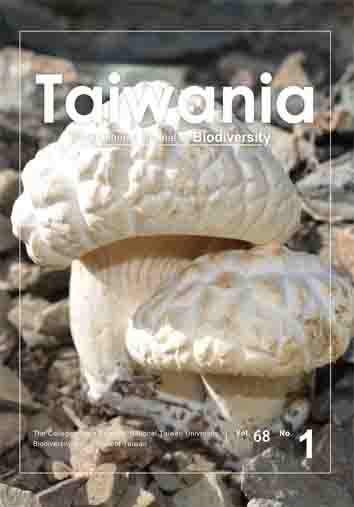Note
New sightings reported in western Indonesia and a preliminary study of Hippa ovalis distribution in Indonesian waters
Vinna Windy Putri, Nisfa Hanim, Kanthi Arum Widayati, Yusli Wardiatno, Achmad Farajallah
Published on: 25 February 2023
Page: 116 - 121
DOI: 10.6165/tai.2023.68.116
Abstract
Species distribution data is essential to understand the patterns of biodiversity, determine areas for conservation, and measure the impact of habitat loss and climate change. In this study, we reported a preliminary study about the distribution pattern of a Hippidae family member, Hippa ovalis. A few reports about H. ovalis in Indonesia have been found, but their distribution patterns remain unknown. The samples were collected from 2018 to 2021; 10 specimens were collected from western and eastern Indonesia. The specimens were identified using morphological and molecular (the COI gene) tools. Our samples primarily included H. ovalis. Gene tree and genetic distance were used to determine the distribution pattern of H. ovalis and to analyze its haplotype network. We found seven haplotypes of H. ovalis among our samples, three shared and four unique. Genetic similarity shows that the western and eastern populations have a close relationship, and we hypothesize that no or minimum barrier can be found among the populations. Furthermore, this widespread dispersal of H. ovalis is probably due to pelagic larval duration and ocean current, particularly the Indonesian Through Flow.
Keyword: Distribution pattern, mole crab, new report, Wallacea
Literature Cited
Ardika, P.U., Farajallah A., Wardiatno, Y. 2015 First record of Hippa adactyla (Fabricius, 1787; Crustacea, Anomura, Hippidae) from Indonesian Waters. TLSR. 26: 105–110.
Bandelt, H.J., Forster, P., R?hl, A. 1999 Median?joining networks for inferring intraspecific phylogenies. Mol. Biol. Evol. 16(1): 37–48.
DOI: 10.1093/oxfordjournals.molbev.a026036View Article
Google Scholar
Barber, P.H., Palumbi, S. R., Erdmann, M.V., Moosa, M.K. 2000 A marine Wallace’s line? Nature. 406(6797): 692–693.
DOI: 10.1038/35021135View Article
Google Scholar
Boyko, C.B., Harvey, A.W. 1999 Crustacea Decapoda: Albuneidae and Hippidae of tropical Indo-West Pacific region. In: Crosnier (eds.) Resultas des campagnes MUSORTOM. Memoirs du Museum national d’Histoire naturelle 20: 379–406.
Boyko, C.B., McLaughlin, P.A. 2010 Annotated checklist of anomuran decapod crustaceans of the world (exclusive of the Kiwaoidea and families Chirostylidae and Galatheidae of the Galatheoidea). Raffles Bull. Zool. 23: 139–151.
Br Silaban, B., Wattimena, M.L., Nanlohy, E.E., Lewerissa, S., Silaban, R. 2020 Morphometric and proximate analysis of mole crabs (Hippa genus) in Maluku Province, Indonesia. AACL Bioflux. 13: 142–151.
Darusman, V., Muskananfola, M.R. 2015. Kelimpahan Undur-Undur Laut (Hippidae) dan sebaran sedimen di Pantai Pagak Kecamatan Ngombol, Purworejo, Jawa Tengah. MAQUARES. 4(1): 9–18.
De Man, J.G. 1895-1898 Bericht ?ber die von Herrn Schiffscapit?n Storm zu Atjeh, an den westlichen K?sten von Malakka, Borneo und Celebes sowie in der Java-See gesammelten Decapoden und Stomatopoden. Zool. Jahrb. Abt. Syst. Geog. Biol. Tiere. 8(4): 485–609.
Gordon, A.L. 2005 The Indonesian seas. Oceanography 18(4): 13.
DOI: 10.5670/oceanog.2005.18View Article
Google Scholar
Hanson, A.J. 1969 The larval development of the sand crab Hippa cubensis (De Saussure) in the laboratory (Decapoda, Anomura). Crustaceana. 16(2): 143–157.
DOI: 10.1163/156854069X00402View Article
Google Scholar
Hebert, P.D., Cywinska, A., Ball, S.L., DeWaard, J.R. 2003 Biological identifications through DNA barcodes. Proc. R. Soc. Lond. B. Biol. Sci., 270(1512): 313–321.
DOI: 10.1098/rspb.2002.2218View Article
Google Scholar
Kumar, R., Rahangdale, S., Roul, S. K. 2018 Filling missing links in albuneid crab distributions (superfamily Hippoidea) in the Bay of Bengal, eastern Indian Ocean. Crustaceana. 91(12): 1495–1504.
DOI: 10.1163/15685403-00003846View Article
Google Scholar
Kumar, S., Stecher, G., Tamura, K. 2016 MEGA7: molecular evolutionary genetics analysis version 7.0 for bigger datasets. Mol Biol Evol 33(7): 1870–1874.
DOI: 10.1093/molbev/msw054View Article
Google Scholar
Librado, P., Rozas, J. 2009 DNASP v5: a software for comprehensive analysis of DNA polymorphism data. Bioinformatics. 25(11): 1451–1452.
DOI: 10.1093/bioinformatics/btp187View Article
Google Scholar
Makarim, S., Sprintall, J., Liu, Z., Yu, W., Santoso, A., Yan, X.-H., Susanto, R.D. 2019 Previously unidentified Indonesian Throughflow pathways and freshening in the Indian Ocean during recent decades. Sci. Rep. 9(1): 1–13.
DOI: 10.1038/s41598-019-43841-zView Article
Google Scholar
Milne-Edwards, A. 1862 Annexe F. Faune carcinologique de l'?le de la R?union. In L. Maillard (eds.), Notes sur l'?le de la R?union. Seconde Partie (pp. 1–19). Annexes, Paris.
Myers, A.A. 1997 Biogeographic barriers and the development of marine biodiversity. Estuar. Coast. Shelf Sci. 44(2): 241–248.
DOI: 10.1006/ecss.1996.0216View Article
Google Scholar
Osawa, M., Boyko, C.B., Chan, T.-Y., Ahyong, S.-T., Macpherson, E. 2010 Crustacean fauna of Taiwan: crab-like anomurans (Hippoidea, Lithodoidea and Porcellanidae). Huayu Nature Book Trade Co.Ltd, Taipei, Taiwan. 198 pages.
R?os-El?segui, D., Hendrickx, M.E. 2014 Records of Hippa strigillata (Stimpson, 1860) (Crustacea: Decapoda: Hippidae) in the SE Gulf of California, Mexico. Nauplius. 22(1): 63–65.
DOI: 10.1590/S0104-64972014000100007View Article
Google Scholar
Sanvicente-A?orve, L., Zavala-Hidalgo, J., Allende-Arand?a, E., Hermoso-Salazar, M. 2018 Larval dispersal in three coral reef decapod species: influence of larval duration on the metapopulation structure. PloS ONE. 13(3): e0193457.
DOI: 10.1371/journal.pone.0193457View Article
Google Scholar
Scheltema, R.S. 1986. On dispersal and planktonic larvae of benthic invertebrates: an eclectic overview and summary of problems. Bull. Mar. Sci. 39:290–322.
Sprintall, J., Wijffels, S.E., Molcard, R., Jaya, I. 2009. Direct estimates of the Indonesian Throughflow entering the Indian Ocean: 2004–2006. J. Geophys. Res. Oceans. 114: C07001.
DOI: 10.1029/2008JC005257View Article
Google Scholar
Subramoniam, T., Gunamalai V. 2003. Breeding biology of the intertidal sand crab, Emerita (Decapoda: Anomura). Adv. Mar. Biol. 46: 91–182.
DOI: 10.1016/S0065-2881(03)46003-3View Article
Google Scholar
Thallwitz, J. 1891. Decapoden-Studien, insbesondere basirt auf A.B. Meyer's Sammlungen im Ostindischen Archipel, nebst einer Aufz?hlung der Decapoden und Stomatopoden des Dresdener Museums. In: Abhandlungen und Berichte des Ko?nigl. Zoologischen und Anthropologisch-Etnographischen Museums zu Dresden. Berlin 3(3): 1–56.
Wardiatno, Y., Ardika, P.U. Farajallah, A., Butet, N.A. Mashar, A. , Kamal, M.M., Renjaan, E.A., Sarong, M.A. 2015. Biodiversity of Indonesian sand crabs (Crustacea, Anomura, Hippidae) and assessment of their phylogenetic relationships. AACL Bioflux. 8: 224–235.
Weersing, K., Toonen, R.J. 2009. Population genetics, larval dispersal, and connectivity in marine systems. Mar. Ecol. Prog. Ser. 393: 1–12.
DOI: 10.3354/meps08287View Article
Google Scholar
Zhao, Q., Stephenson, F., Lundquist, C., Kaschner, K., Jayathilake, D., Costello, M.J. 2020. Where marine protected areas would best represent 30% of ocean biodiversity. Biol Conserv. 244:108536.
DOI: 10.1016/j.biocon.2020.108536View Article
Google Scholar


